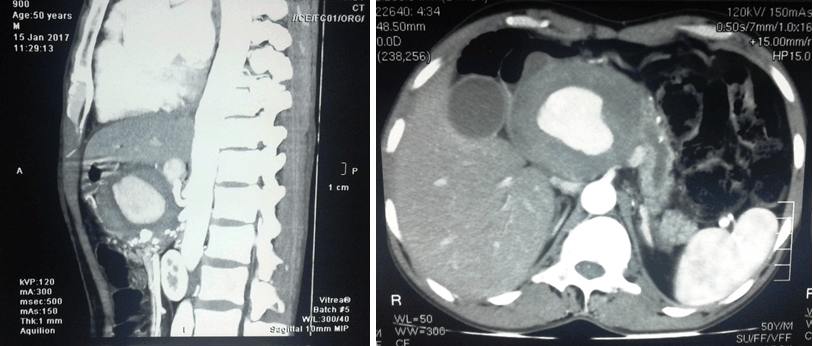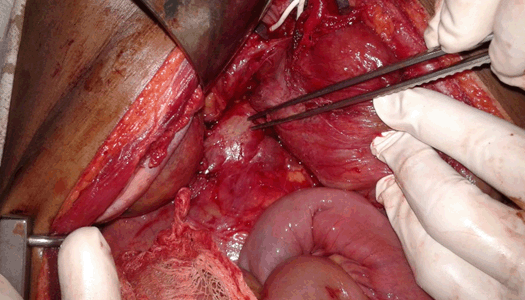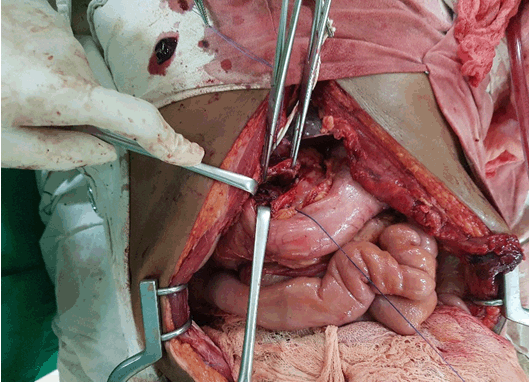
|
 |
|
Case Report
| ||||||
| Superior pancreaticoduodenal artery pseudoaneurysm complicated with fistulation into common bile duct and duodenum: A case report | ||||||
| Samarasinghe A.S.1, Chathuranga L.S1, Niyas S.M.M.2 | ||||||
|
1Department of Surgery, Teaching Hospital Kandy
2Department of Surgery, Teaching Hospital Kandy | ||||||
| ||||||
|
[HTML Abstract]
[PDF Full Text]
[Print This Article] [Similar article in Pumed] [Similar article in Google Scholar] 
|
| How to cite this article |
| Samarasinghe AS, Chathuranga LS, Niyas SMM. Superior pancreaticoduodenal artery pseudoaneurysm complicated with fistulation into common bile duct and duodenum: A case report. Int J Case Rep Images 2017;8(9):601–603. |
|
ABSTRACT
| ||||||
|
Introduction:
Visceral artery aneurysms are a rare clinical entity with life-threatening complications such as rupture, associated with high mortality. Keywords: Duodenum, Fistulation, Pseudoaneurysm, Superior pancreaticoduodenal artery | ||||||
|
INTRODUCTION
| ||||||
|
True and false aneurysms of the visceral arteries form an important entity of vascular pathology though it is rare. Visceral artery aneurysms (VAAs) represent 0.1–0.2% of all vascular aneurysms and most commonly found in splenic (60%), hepatic (20%) and superior mesenteric (9%) arteries [1][2][3] . Pancreaticoduodenal artery aneurysms (PDAA) are rare, accounting for only 2% of all splanchnic artery aneurysms, but it is an important vascular disease because of its potential for fatal rupture [4]. False pancreaticoduodenal artery aneurysms occurs due to surrounding inflammatory response in cases like pancreatitis, abdominal trauma, septic emboli or laparoscopic cholecystectomy. They often rupture into the gastrointestinal tract, whereas true aneurysms are usually associated with coeliac axis stenosis, and rupture into the retroperitoneal space [3] [4]. We present a case with pseudoaneurysm of superior pancreaticoduodenal artery fistulized into the duodenum. | ||||||
|
CASE REPORT
| ||||||
|
A 50-year-old male was presented to our hospital with a five-week history of persistent epigastric pain associated with indigestion weight loss, and melena. On physical examination he was icteric and had an epigastric tenderness but no palpable masses detected. Biochemical investigations revealed obstructive jaundice with elevated total (135.8 µmol/l) and direct bilirubin levels (114.2 µmol/l). Abdominal ultrasonography reported an aneurysmal dilatation (5.1x5.8x4.8 cm) in the epigastric region with wall thickness of 1.4cm. Upper gastrointestinal endoscopy demonstrated an ulceration of mucosa of second part of the duodenum with active bleeding (Figure 1). Contrast enhanced computed tomography scan of the abdomen showed a pseudoaneurysm in the superior pancreaticoduodenal artery. Superiorly there was a linear high density within the hypodense wall which could be contrast leak into intramural thrombus. Pancreatic head is compressed and there are multiple foci of coarse calcifications within the head of the pancreas. Pancreatic duct is dilated (9.1 mm). Second part of the duodenum is compressed by the lesion. Gallbladder is distended and common bile duct is dilated (1.3 cm). Hepatic artery originates directly from the aorta. An explorative laparotomy performed and aneurysmal dilatation of superior pancreaticoduodenal artery identified. Aneurysm sac opened and feeding artery ligated from inside. Two fistulous openings into second part of the duodenum and to the common bile duct identified and repaired (Figure 2) and (Figure 3). The patient was discharged one week later after complete recovery. | ||||||
| ||||||
| ||||||
| ||||||
|
DISCUSSION
| ||||||
|
Aneurysm of the pancreaticoduodenal artery is rare accounting for about 2% of all splanchnic aneurysms [4]. Clinical manifestations depend on the type of aneurysm. True aneurysms are associated with coeliac axis stenosis, while pseudoaneurysms are known to rupture into gastrointestinal tract as in this case [4][5]. Long standing alcohol use favors chronic pancreatitis as being the underlying cause. Aneurysm had exerted sufficient pressure to cause both common bile duct and pancreatic duct dilatation. Acute hemorrhage is a life-threatening complication of pseudoaneurysm, with a high mortality rate of up to 37% [6]. Brocker et al. reviewed 93 cases of PDAAs with celiac stenosis or occlusion and reported both that 52% were ruptured at the time of presentation and that aneurysm size did not correlate with rupture [7]. These results emphasize that PDAAs should be treated at the time of diagnosis. Surgical (e.g., ligation, resection, or pancreaticoduodenectomy) or endovascular embolization are the two main treatment modalities practiced. Surgical correction of visceral aneurysm considered to be the gold standard [8][9] while endoluminal procedures have now become the first line of therapy instead of surgery in most instances, especially in an emergency setting. | ||||||
|
CONCLUSION
| ||||||
|
We report a rare case of a patient with pancreaticoduodenal artery aneurysm complicated with fistulation into common bile duct and duodenum. High index of suspicion and timely intervention helps in optimal outcome. | ||||||
|
REFERENCES
| ||||||
| ||||||
|
[HTML Abstract]
[PDF Full Text]
|
|
Author Contributions
Samarasinghe A.S. – Substantial contributions to conception and design, Acquisition of data, or analysis and interpretation of data, Drafting the article, Final approval of version to be published Chathuranga L.S. – Substantial contributions to conception and design, Acquisition of data, Analysis and interpretation of data, Drafting the article, Final approval of version to be published Niyas S.M.M. – Substantial contributions to conception and design, Acquisition of data, Drafting the article, Final approval of version to be published |
|
Guarantor
The corresponding author is the guarantor of submission. |
|
Source of support
None |
|
Conflict of interest
Authors declare no conflict of interest. |
|
Copyright
© 2017 Samarasinghe A.S. et al. This article is distributed under the terms of Creative Commons Attribution License which permits unrestricted use, distribution and reproduction in any medium provided the original author(s) and original publisher are properly credited. Please see the copyright policy on the journal website for more information. |
|
|






